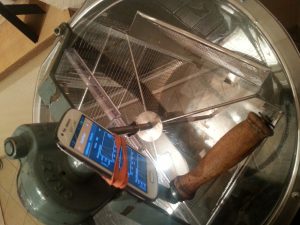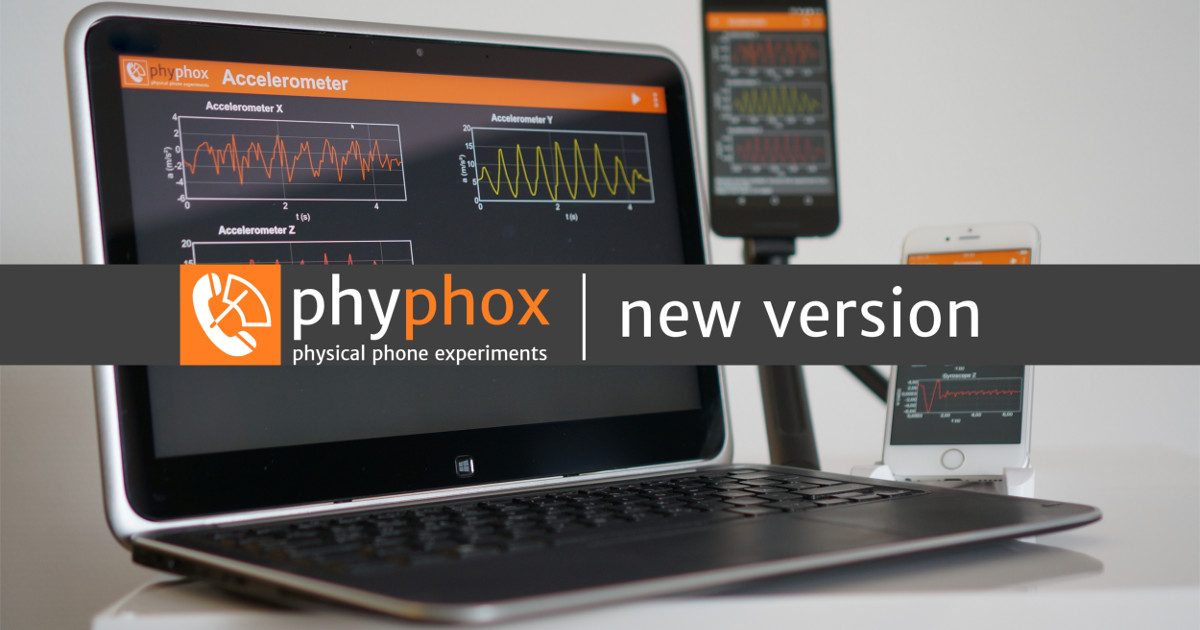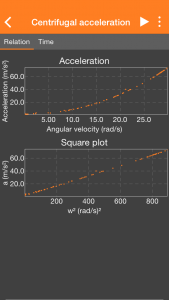Today I had a great day at the phaeno science center. On 11th and 12th of March, they will be doing an exhibition on physics experiments with smartphones, so today we had a lot of fun trying out a bunch of ideas for this event. So, here is a little teaser video…
Category: News
Honey separator
 One of our users, Christian, wondered about the centripetal (or centrifugal, depending on your reference system) force in his honey separator. He basically has got a centrifuge for his honeycombs which extracts the honey using this force, but unlike our experiment using a salad spinner, he was unable to measure the acceleration directly because it exceeds the range of the sensors in his smartphone. So, instead he attached his phone to the crank of the centrifuge and created his own phyphox experiment, which uses the gyroscope to determine the rotation speed of the crank. From this, his experiment then derives the speed of the centrifuge itself and all the forces involved, taking into account the transmission of the crank as well as the radius at which the honeycombs are placed within the centrifuge. If you are interested in this, here is a link to directly open his exeriment in phyphox and a link to download his phyphox file defining the experiment.
One of our users, Christian, wondered about the centripetal (or centrifugal, depending on your reference system) force in his honey separator. He basically has got a centrifuge for his honeycombs which extracts the honey using this force, but unlike our experiment using a salad spinner, he was unable to measure the acceleration directly because it exceeds the range of the sensors in his smartphone. So, instead he attached his phone to the crank of the centrifuge and created his own phyphox experiment, which uses the gyroscope to determine the rotation speed of the crank. From this, his experiment then derives the speed of the centrifuge itself and all the forces involved, taking into account the transmission of the crank as well as the radius at which the honeycombs are placed within the centrifuge. If you are interested in this, here is a link to directly open his exeriment in phyphox and a link to download his phyphox file defining the experiment.
Thanks to Christian for sharing this unusual application with us.
Mysterious christmas message!
Check out our christmas experiment and decode it with phyphox!
News from the last week
Besides releasing a minor update with a bunch of fixes, there has been a lot of great coverage of phyphox over the last week. So, here they are in no particular order (well, I put the English ones at the top).
AAPT webinar: Using smartphones to teach physics
Well, this is not exactly press coverage and technically it’s not in the past seven days, but I still want to mention this at the top, because it was a great web-event by the American Association of Physics Teachers (AAPT) on December the 10th, which brought together many people from around the globe pioneering smartphone physics. Thanks a lot to AAPT’s Rebecca Vieyra for hosting the session. Hopefully, a recording will be available online soon…
Gorilla Physics
Kit Betts-Masters, a physics teacher from the UK, has covered phyphox on his Youtube channel “Gorilla Physics”, which you can check out here.
Bildung Zukunft Technik (German)
There was a short but enthusiastic mention in the German podcast bildung-zukunft-technik.de in their “nice apps” category.
chip.de (German)
The widely known German computer magazine has covered us on their webpage in their app category.
iphone-ticker.de (German)
On the 10th of December, iphone-ticker.de featured an article about phyphox on their front-page, which generated an estimate of 10.000 new installs on Apples App Store over the weekend.
Die Zeit (German)
The German newspaper “Die Zeit” (edition from 15 Dec, p. 38) mentioned phyphox in an article about presents for those enthusiastic about knowledge and technology.
One More Thing (Dutch)
At the beginning of the week (12 Dec), we were featured on onemorething.nl from the Netherlands.
Version 1.0.5 (minor improvements and fixes)
As I explained in the last update I am mostly working on the next major update and there will only be updates in-between to fix bugs. Well – this is one of those updates.
Changes for both Android and iOS
- We now use the calibrated magnetometer by default and allow switching to the raw magnetometer from the menu if available on the device.
- Added an explanation link to the sensor-not-available notification.
- Acoustic stopwatch now supports multiple timers and allows for setting a minimum delay.
- Sonar now features a reverse mode where you enter a distance and can determine the speed of sound.
- Fix: Append-module now accepts value-type input.
- Fix: Update fails when switching to raw data in remote experiment of the roll experiment (and possibly others).
- Fix: Some spelling errors in the experiments.
Changes for Android
- Fix: Very short audio loops failed.
- Fix: Remote access failed when infinite numbers occur.
- Fix: Crash on Samsung Galaxy S4 when repeatedly playing audio.
Changes for iOS
- Fix: Run analysis even when not triggered by a sensor event to allow for self-modifying experiments like a gradually changing tone generator.
- Fix: Possible crash in average module (race condition mostly triggered on iOS8).
- Fix: Axis labels were not translated in the remote interface.
- Fix: Crash in binning module when dx is set to zero.
- Fix: Handle audio setup changes (plugging in a headset) more gracefully.
Experiment: Centrifugal Acceleration
The experiment, which explores centrifugal acceleration in a salad spinner, has only been added in the update before the last one. But it has become one of our favorites as few others are that simple and yet give such beautiful results.
Version 1.0.4: Acoustic Stopwatch
So, here is the new update 1.0.4 with our new experiment: The acoustic stopwatch. Again, this is more a tool than a full experiment, but a very useful one. The watch starts counting when there is a noise above a (selectable) threshold and it will stop again on a second noise.
A simple usage case is a free fall experiment, in which you create the first noise when releasing a weight (for example by popping a balloon or hitting a mount) and the second sound is generated by the impact of the weight. Of course, there are some other improvements and bugfixes as well as an update to the file format (to make the acoustic stopwatch possible). You will find the full list at the end of this post.
Future plans
For now, it looks like this will be the last minor 1.0.x update and I will now start working on the next major step, which will be 1.1.0. Of course, if there are some major bugs or a nice new experiment, which can easily be added, there will be a 1.0.5 inbetween, but for now I will look at the two major changes: Better graphs (zooming, multi-data etc.) and a better workflow for custom experiments without transferring the files manually.
Unfortunately, I cannot tell when this will be ready. This depends on how much time I am able to invest and on how complex the new features are. Also, the graphs will require some testing before an official release – but I will share info on the progress.
Now for the changelog:
Main Changes
- New experiment: Acoustic stopwatch
- More options when exporting in CSV format: There now are variants with a comma as decimal point and the number format is now consistent across both platforms.
- Grey out experiments that are unavailable
- Add video links to the experiment menu as well (or any link marked as highlight)
Changes to the phyphox file format
- New analysis module: if
- New view element: button
- New initializing attribute for buffers
Fixes for Android
- Improved behavior when hiding keyboard
- Fix possible crash when switching to different app
- Update views in stopped state
- Fix auto-orientation not respecting system setting
- Fix opening phyphox:// URLs with parameters
- Fix for the (half-official) Bluetooth support. Note, that this will changed and replaced by Bluetooth 4.0 / BLE in the future.
- Apply size setting of value view element to the remote interface.
Fixes for iOS
- Fix magnetometer calibration factor. (Note: We are using the uncalibrated magnetometer values, which may be way off from what you expect for small fields like the earth’s magnetic field, but which should be good for stronger field. However, we might switch to the calibrated one in the future to avoid confusion, but which might introduce other problems.)
- Fix for not stripping trailing zeros if a fixed number of digits is defined for a value view element
New events and chances to meet us
Just a quick update on two new opportunities in NRW to see us and discuss ideas:
Version 1.0.3 with new experiments
In this new update two new experiments have been added: Centrifugal acceleration and inclination. While the latter is just a tool to measure the inclination of a plane, centrifugal acceleration is a lot of fun while being amazingly simple. Just rotate your phone at a fixed radius r at different angular velocities ω to visualize the relation of the centrifugal acceleration a.
In other words: Just put your phone into a salad spinner or on a carrousel to show a = r·ω². (The picture shows an earlier version of the experiment using a salad spinner)
Besides that, 1.0.3 introduces some new analysis modules (the wiki will be updated in the next few hours) and addresses many bugs, especially two common crashes on iOS. Here is the full changelog:
Changes
- New experiments: Centrifugal force and inclination
- Simple view for raw sensors, just giving numbers
- Improved descriptions and labels for several experiments
- Better time axis calculation in elevator experiment
- Updated experiment file format to 1.2: New modules for statistics and trigonometry. Also more control over value and graph view elements.
Fixes on iOS
- Disappearing view elements after rotation or scrolling
- Crash when starting web interface on iOS8
- Crash when entering zeros in Doppler effect
- Crash in autocorrelation module (experiments “Spring”, “Pendulum” and “Autocorrelation”)
- Missing data points in remote interface (mostly elevator and roll)
- Could not open external experiments on iOS8
- Strip white-spaces from description
Fixes on Android
- Fix wrong play-button animation after screen being turned off
- Do not show the save-locally-dialog again after rotation
- Show “-” instead of “NaN” when no data is available
- Improved reliability of remote interface when doing partial data updates
- Fix possible crash when switching apps while graph is visible
- Fix crash when closing experiment without dismissing the info-tooltip
Experiment: Sonar
The sonar might be one of the most fascinating experiments, but also one of the most confusing ones if you do not know how to do it properly. This video explains, how to turn your phone into a sonar.



